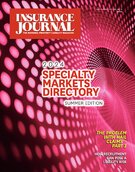The dilemma in today’s labor market is real.
In 2023, the U.S. labor market had 9.5 million unfilled jobs. Yet there were just 6.5 million unemployed workers, according to the U.S. Chamber of Commerce. If every unemployed person found a position tomorrow, there would still be over two million open positions.
Finding talent today is a struggle at best. Finding talent within the insurance industry? As difficult as it comes.
It’s no secret that the industry has long struggled with attracting and retaining talent. As far back as 2015, millennials showed little interest in working for insurance and insurance-related organizations — The Hartford’s 2015 Millennial Leadership Survey revealed that just 4% of millennials were considering a career in insurance.
Fast forward to today and not much has changed. A Pew Research study shows that interest in the industry has held at 4% as recently as 2023. Ironically, millennials will make up 75% of the workforce by 2025.
While the industry struggles with attracting and retaining younger generations of workers, it is also grappling with some pretty hard facts. According to NAMIC data, 50% of today’s insurance workforce is looking toward retirement by 2028. That could leave the industry with a dearth of workers and the inability to expand and grow business.
Facing this twofold issue is daunting. Attracting young talent to the industry is key. However, the more immediate need is to have enough talent available to get the job done. That will require some innovative thinking and a retooling of how business is conducted and who our next workers will be.
The Returning Retiree
Fortunately for the industry, not every retirement-aged insurance professional wants to quit working cold turkey. In fact, a CNBC All-America Workforce survey found that over two-thirds of U.S. workers (68%) who retired during the pandemic would consider returning to work and 94% who left the workforce but didn’t officially retire would do the same.
Even as workers retire, many of the same age demographic are rethinking what their retirement should look like. The Bureau of Labor Statistics finds that a surprising 27% of people aged 65 to 74 are actively seeking employment, many of them already retired, which makes the 65-plus crowd the fastest-growing segment of the workforce. Retired workers are reshaping retirement, which could be the salvation that the insurance industry desperately needs to fill so many open positions.
However, employers are having a tough time embracing them. Retired workers are often passed over as viable options for filling open positions, with organizations unwilling to engage a worker who isn’t interested in the traditional nine-to-five.
Organizations assume they are not as engaged and not as likely to be in the position in five years — assumptions that are inaccurate. Instead, organizations should be realizing how much potential a retired insurance professional can deliver.
That includes how we view the retired worker demographic. Many talented individuals who have retired are looking for new ways to utilize a wealth of career knowledge and skill that doesn’t require commutes or being in the office every day. They may also prefer a less stressful position at lower pay as they are no longer on a career path. Organizations should be willing to meet them where they are.
That starts with letting go of preconceived impressions of older workers. Too many managers and organization leaders think that older workers:
- Are less productive than younger workers
- Are resistant to change
- Have difficulty learning new skills
- Don’t use technology or understand it
All of which are not true. Study data from the Center for Retirement Research at Boston College show that workers between the ages of 60 and 74 are more productive than younger workers. Older workers also are more open to change, according to the Centers for Disease Control (CDC), and have more experience with changes in the organization than do their younger coworkers.
Likewise, retired workers have amassed a career full of new skills learned. These are workers who were on the job as technology was adopted and refined. They were the first generation of workers to learn how to implement technology on the job. Older workers are not averse to learning new skills — in fact, they often welcome and embrace learning. In many ways, these veteran workers should be valued for the skills they bring and their proven ability to adapt to change.
Perhaps organizations should adopt the same attitude toward change. In order to be more resilient and agile, organizations need to approach workforce engagement and retention in a new way.
Make no mistake — our industry has proven its ability to respond with flexibility. That same resilience and agility certainly came to the forefront amid the Covid-19 pandemic. Insurance organizations seemingly overnight learned how to pivot hard, revamping business to run on a remote work model. With customer satisfaction and service being top of mind, insurance adapted.
Yet can the industry adapt its way of thinking about the workforce?
Traditional methods for filling open positions need to change. Our industry could use a refresher in implementing that same flexibility that helped us through the pandemic.
Solving the Talent Dilemma
Solving the talent shortage, therefore, should include a way to reconnect with retired workforce members. The benefits your organization can attain in doing so are real. A Wall Street Journal article revealed that certain companies are seeking out the talents of seniors, calling their age “an asset.”
Employers say that older workers bring:
- Dedication to the company
- Customer service focus
- Dependability
- High productivity
- Strong work ethic
- Institutional knowledge
And studies prove that. An AARP/Aon Hewitt report reveals that 65% of employees 55 years and older are engaged in the workplace.
Another benefit: By considering using retired workers in work-from-home arrangements, your organization can significantly expand the talent pool, removing geographic boundaries and
giving you more potential for finding the right candidate for the position.
That older, experienced candidate can also become a mentor. Career insurance veterans have amassed a wealth of experience that they can pass along to a new generation of workers. They also can bring a vast network of contacts and knowledge with them to every job.
The best part about hiring retired workers to work from home for your organization: They can be up and running quickly. It takes just a few changes to your communication process, namely adding chat and video conferencing to the ways with which you engage your workers.
Espousing Better Hiring Decisions
As the labor shortage in insurance deepens, employers must learn to shed their misconceptions about age and the retired worker. Retired workers bring with them a wealth of experience, soft skills, and a wide network of contacts. The smart organization is one that finds a way to utilize those attributes.
Your remote workforce needs just a few changes to your current employee management processes — changes that can improve your overall company culture.
Adopt better hiring outreach to include remote and retired professionals.Instill more proactive communication.
These small changes can help improve not just the experience for your remote and hybrid teams, but for the entire organization. A stronger organization improves retention and makes your organization the one that job seekers want to work for.
Was this article valuable?
Here are more articles you may enjoy.



 Questions About How a Deputy’s Stepson Became the Accused Gunman at FSU Shooting
Questions About How a Deputy’s Stepson Became the Accused Gunman at FSU Shooting  Group Sues California Department of Insurance Over FAIR Plan Surcharges
Group Sues California Department of Insurance Over FAIR Plan Surcharges  Global Q1 Commercial Insurance Rates Drop 3%, but US Casualty Bucks the Trend
Global Q1 Commercial Insurance Rates Drop 3%, but US Casualty Bucks the Trend  Dog Bite Claims Soar in Frequency and Cost: Report
Dog Bite Claims Soar in Frequency and Cost: Report 



